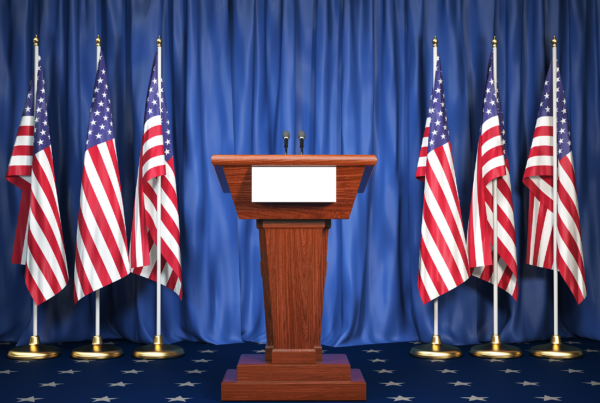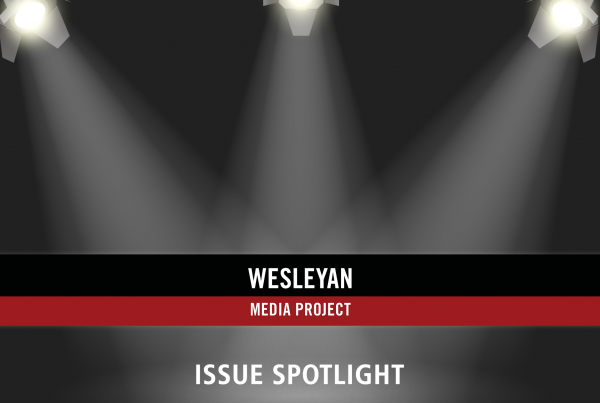Trump, Biden Give Little Attention to South Carolina
(MIDDLETOWN, CT) February 16, 2024 – The volume of television advertising in the 2024 presidential race has fallen dramatically since the January 23 New Hampshire primary. In the weeks since New Hampshire, candidates and the groups and parties supporting them have spent only $2.6 million on under 8,000 ad airings on broadcast television stations. (This figure omits an estimated $7 million in spending on an ad that aired during the Super Bowl by the American Values super PAC, which backs Robert F. Kennedy, Jr.)
Figure 1, which shows the number of broadcast ads aired each week in the race, confirms that the decline in advertising in 2024 took place earlier than in the past three presidential races. At this time in 2020, thanks to huge spending by Michael Bloomberg and Tom Steyer in the Democratic primary race, over 60,000 were being aired each week, but this year, ad airings since New Hampshire have been below 4,000 per week.
“The presidential nomination race has winnowed faster than in any other year in recent memory,” said Erika Franklin Fowler, co-director of the Wesleyan Media Project. “The drop in advertising that we might typically see after Super Tuesday has already happened.”
Figure 1: Weekly Presidential Ad Airings Over Time (by Cycle)
Numbers include broadcast television for all sponsors for the period between January 1 of the off-year and February 11 of the election year.
CITE SOURCE OF DATA AS: Vivvix CMAG with analysis by the Wesleyan Media Project.
Trump Largely Absent from South Carolina
In South Carolina, with a February 24 Republican primary, Nikki Haley is the only remaining candidate who has spent a substantial sum of money in the state. Table 1 shows that the Haley campaign has spent about $1.2 million on 5,500 broadcast ad airings in the state, and the Stand for American Fund, which backs Haley, has spent another $400,000 on about 700 ad airings. AFP Action has aired one unique spot nearly 1,800 times to the tune of nearly $1 million, touting Haley’s chance at beating Biden in the general election. By contrast, Donald Trump’s campaign–and his Make America Great Again super PAC–have spent nothing on broadcast ads in the state. Biden and the DNC have spent about $130,000 in South Carolina, which included some advertising aimed explicitly at Black voters in particular.
Table 1: Broadcast Ad Airings and Spending in South Carolina (Full Cycle)
| Airings | Est. Spend (in $Ms) |
|
|---|---|---|
| Biden (plus DNC) | 424 | 0.13 |
| Future Forward (and allies) (pro-Biden) | 0 | 0 |
| Trump | 0 | 0 |
| Make America Great Again (pro-Trump) | 0 | 0 |
| Haley | 5,571 | 1.23 |
| Stand for America Fund (pro-Haley) | 672 | 0.42 |
| AFP Action (pro-Haley) | 1,795 | 0.99 |
| All others (all aired in 2023) | 4,346 | 4.99 |
| Numbers include broadcast television for all sponsors for the period between 1/1/23 and 2/11/24. CITE SOURCE OF DATA AS: Vivvix CMAG with analysis by the Wesleyan Media Project. |
||
Table 2 expands the focus to ads on local cable stations and radio, as well as satellite television. Trump, off the air on broadcast in South Carolina, has spent nearly $400,000 on these other other platforms. AFP Action has been very active in the state, spending over $1.7 million on ads on cable, satellite, and radio.
Table 2: Cable, Radio, and Addressable Spending in South Carolina (Full Cycle)
| Local cable (in $Ms) | Radio (in $Ms) | Addressable (in $Ms) |
|
|---|---|---|---|
| Biden (plus DNC) | 0.10 | 0.20 | 0 |
| Trump | 0.29 | 0 | 0.10 |
| Make America Great Again (pro-Trump) | 0 | 0 | 0 |
| Haley | 0.26 | 0 | 0 |
| Stand for America Fund (pro-Haley) | 0.35 | 0 | 0.11 |
| AFP ACTION | 0.73 | 0.40 | 0.60 |
| Numbers include broadcast television for all sponsors for the period between 1/1/23 and 2/11/24. CITE SOURCE OF DATA AS: Vivvix CMAG with analysis by the Wesleyan Media Project. |
|||
Overall Presidential Ad Spending Over $300 Million
The early denouement to the presidential nomination race, however, does not mean overall low spending. In the presidential race to-date through February 11, 2024, candidates and supportive groups have aired over 200,000 broadcast and national television spots, costing over an estimated $220 million (Table 3). President Biden (in coordination with the Democratic National Committee) has spent over $14 million, while a super PAC backing his re-election, Future Forward, has spent $16 million. However the bulk of broadcast and local TV spending thus far has come from the Republicans. Donald Trump and Nikki Haley have spent nearly the same, $7 million, with the main super PACs backing each candidate also going toe-to-toe, and with spending that far exceeds the candidates.
In addition to the spending on broadcast and national cable television, about $50 million has been spent on local cable television and another almost $10 million on radio ads.
Across the six sponsors in Table 3, an additional $29 million has been spent on Facebook and Google platforms. The vast bulk of that is from the Biden campaign, with $18 million, two-thirds of which was on Facebook ads. Trump has spent over $3 million on digital ads, split evenly between Facebook and Google ads.
Table 3: Ad Airings and Spending in Presidential Race (Full Cycle)
| Broadcast and national cable (in $Ms) | Local cable (in $Ms) | Radio (in $Ms) | Meta + Google (in $Ms) |
|
|---|---|---|---|---|
| Biden* | 14.69 | 2.30 | 0.63 | 18.76 |
| Future Forward (and allies) (pro-Biden) | 16.09 | 3.80 | 0.23 | 1.94 |
| Trump** | 6.81 | 5.75 | 0.86 | 3.39 |
| Make America Great Again (pro-Trump) | 35.95 | 1.95 | 0.08 | 1.14 |
| Haley | 7.14 | 1.94 | 1.37 | 0.62 |
| Stand for America Fund (pro-Haley) | 36.63 | 8.94 | 0.62 | 3.16 |
| All others | 110.92 | 25.42 | 5.89 | n/a |
| Total | 228.23 | 50.10 | 9.68 | |
| Numbers include broadcast television for all sponsors for the period between 1/1/23 and 2/11/24. CITE SOURCE OF DATA AS: Vivvix CMAG with analysis by the Wesleyan Media Project. *Biden totals include coordinated spending with the DNC for television, and Biden Victory Fund spending on digital platforms. **Trump spending includes Trump Save America Joint Fundraising Committee spending on digital platforms. |
||||
Most Ad Spending in Iowa, NH
The bulk of ad spending to date has been in Iowa and NH, as shown in Table 4. About 35 percent of total presidential spending thus far was in Iowa, a total of $82 million. All of those were aired in the Republican race. Nearly $30 million in additional spending was on radio and local stations, making the total for the Iowa caucus over $110 million in advertising. New Hampshire saw over $65 million in spending on ads–all but $5 million of that on the Republican side. The bulk of the spending in the state was on broadcast television spots, totaling about 35,000 ad airings.
Table 4: Ad Airings and Spending in Iowa and New Hampshire (Full Cycle)
| pro-Dem (broadcast) | 0 | 0 |
| pro-Dem (local cable and radio) | n/a | 0 |
| pro-Rep (broadcast) | 122,875 | 81.95 |
| pro-Rep (local cable and radio) | n/a | 29.36 |
| New Hampshire | Airings | Spending |
| pro-Dem (broadcast) | 2,742 | 3.16 |
| pro-Dem (local cable and radio) | n/a | 1.28 |
| pro-Rep (broadcast) | 31,807 | 42.77 |
| pro-Rep (local cable and radio) | n/a | 19.66 |
| Numbers include broadcast television for all sponsors for the period between 1/1/23 and 2/11/24. CITE SOURCE OF DATA AS: Vivvix CMAG with analysis by the Wesleyan Media Project. |
||
Television Ad Volumes Now Fail to Match 2020, 2016 Totals
Figure 2 shows that the volume of broadcast television advertising in 2024 – just above 200,000 airings – is well below the record-setting 678,000 airings of 2020 (which featured two billionaire candidates, Michael Bloomberg and Tom Steyer) and is just slightly below the volume in 2016 (205,468).
“Although many Republicans put their hats in the ring for the presidency, the field quickly contracted, which may help explain why ad volumes this year are not breaking records,” said Travis Ridout, co-director of the Wesleyan Media Project. “Moreover, campaign ad budgets have been slowly shifting to digital, and thus television, while still important, is not as dominant as it once was.”
Figure 2: Volume of Presidential Ad Airings by Cycle
Numbers include broadcast television for all sponsors for the period between January 1 of the off-year and February 11 of the election year.
CITE SOURCE OF DATA AS: Vivvix CMAG with analysis by the Wesleyan Media Project.
Attacks on Trump Main Focus of Haley Ads; Biden Runs Positive Campaign
The presidential race has taken a negative turn over the past month, with Nikki Haley’s campaign attacking both Trump and Biden in its messaging. In fact, Table 5 shows that between January 8 and February 11, 90 percent of Haley’s ad airings have included an attack on Trump, and 75 percent have included an attack on Biden. Many ads from the pro-Haley super PAC, Stand for America Fund, have also included attacks on Trump, Biden and Ron DeSantis (before he dropped out of the race).
Trump, by contrast, has ignored Haley in his advertising, reserving his attacks for Biden. Seventy percent of the Trump campaign’s ads since January 8 have included an anti-Biden attack. Biden, by and large, has not returned the favor. Most of his campaign’s ads (some sponsored in coordination with the DNC) have focused on telling a positive message about Biden; only one in five has mentioned Trump.
Table 5: Candidate Mentions (Jan 8 to Feb 11)
| Sponsor | Message | Airings | Percent of airings |
|---|---|---|---|
| Nikki Haley (10,289 airings) | Anti-Trump | 9,211 | 89.5% |
| Anti-Biden | 7,759 | 75.4% | |
| Stand for America Fund (pro-Haley) (3,193 airings) | Anti-Trump | 2,259 | 70.7% |
| Anti-Biden | 1,657 | 51.9% | |
| Anti-DeSantis | 1,638 | 51.3% | |
| Trump (9,947 airings) | Pro-Trump | 9,947 | 100.0% |
| Anti-Biden | 7,040 | 70.8% | |
| Make America Great Again (pro-Trump) (1,303 airings) | Pro-Trump | 1,247 | 95.7% |
| Anti-Biden | 0 | 0.00% | |
| Biden/DNC (494 airings) | Pro-Biden | 488 | 98.8% |
| Anti-Trump | 91 | 18.4% | |
| Numbers include broadcast television for all sponsors for the period between 1/8/24 and 2/11/24. CITE SOURCE OF DATA AS: Vivvix CMAG with analysis by the Wesleyan Media Project. |
|||
Table 6 examines the pattern of attacks across all sponsors within party, starting in early 2023. On the Democratic side, most ads focus on promoting Biden, with only a small percentage of pro-Democratic ads (11 percent) contain an attack on Trump. On the Republican side, attacks were divided between Biden (found in 45 percent of ad airings), Trump (found in 28 percent of ad airings) and DeSantis (found in 25 percent of ad airings). Clearly, Trump did not escape the scrutiny of his Republican opponents and the groups advertising in the nomination race.
Table 6: Percentage of Attacks by Sponsorship and Target
| Democratic Presidential ads (26,861 total airings) | Airings | Percent of airings |
|---|---|---|
| Pro-Biden message | 23,351 | 86.9% |
| Anti-Trump | 2,984 | 11.1% |
| Republican Presidential ads (174,602 total airings) | Airings | Percent of airings |
| Anti-Biden message | 78,937 | 45.2% |
| Pro-Trump | 33,195 | 29.5% |
| Anti-Trump | 31,155 | 28.5% |
| Anti-DeSantis | 22,302 | 24.8% |
| Pro-DeSantis | 18,789 | 20.7% |
| Numbers include broadcast television for all sponsors for the period between 1/1/23 and 2/11/24. CITE SOURCE OF DATA AS: Vivvix CMAG with analysis by the Wesleyan Media Project. |
||
Democratic Presidential Race Focused on Healthcare; Republicans on International Affairs
Table 7 shows the top issues discussed in the presidential race in both pro-Democratic and pro-Republican advertisements. The numbers include all ads aired since early 2023 and include all sponsors, including candidates, parties and groups. The takeaway is that the issue agendas across parties are quite different.
Pro-Democratic ads–many of them sponsored by Biden and groups that support his candidacy–have focused on healthcare, prescription drugs, the economy and energy/the environment. None of these issues is in the top four in pro-Republican ads, which have focused on international affairs, immigration, the budget and China.
“Perhaps surprisingly, Democrats have talked more about inflation than have Republicans,” said Michael Franz, co-director of the Wesleyan Media Project. “This may reflect the fact that inflation has declined considerably in recent months. Another surprise is that abortion, which was at the top of Democrats’ issue agenda in 2022, has rarely been mentioned in Democratic presidential ads over the past year.”
Table 7: Top Issues in Presidential Ads (all sponsors, cycle-to-date)
| Pro-Democratic | Pro-Republican | ||
|---|---|---|---|
| Healthcare | 54.3% | International Affairs | 29.5% |
| Prescription Drugs | 50.6% | Immigration | 28.5% |
| Economy | 48.0% | Budget | 24.8% |
| Energy/Environment | 46.8% | China | 20.7% |
| Inflation | 39.6% | Economy | 20.3% |
| Jobs | 33.5% | Taxes | 17.4% |
| Utility Rates | 29.5% | Public Safety | 14.5% |
| Manufacturing | 27.3% | Energy/Environment | 11.7% |
| Transportation | 24.2% | Seniors | 11.2% |
| Seniors | 20.0% | Jobs | 9.3% |
| Numbers include broadcast television for all sponsors for the period between 1/1/23 and 2/11/24. CITE SOURCE OF DATA AS: Vivvix CMAG with analysis by the Wesleyan Media Project. |
|||
About the Data
All television, addressable (which includes satellite and connected TV from LG Ad Sales), and radio data reported here are from Vivvix CMAG. Unless otherwise specified, most advertising references refer to broadcast television. All cost estimates for television are precisely that: estimates.
Meta (Facebook and Instagram) spending data come from the ad library aggregate reports, which provide spending information for each page name and disclaimer combination. Totals in this report reflect spending between January 1, 2023 and February 10, 2024. These totals are calculated by subtracting the reported cumulative spending (as reported by Facebook as the total spent since May 2018) for the February 10, 2024 report and subtracting the cumulative spending reported for December 31, 2022.
For Google ads, we downloaded the weekly reports from the platform’s Transparency Report. The totals reflected in this release are current as of February 14, 2024, the day on which we pulled the transparency report. Google spending is from the following time periods: January 1, 2023 and February 10, 2024.
About this Report
The Wesleyan Media Project provides real-time tracking and analysis of all political television advertising in an effort to increase transparency in elections. Housed in Wesleyan’s Quantitative Analysis Center – part of the Allbritton Center for the Study of Public Life – the Wesleyan Media Project is the successor to the Wisconsin Advertising Project, which disbanded in 2009. It is directed by Erika Franklin Fowler, professor of government at Wesleyan University, Michael M. Franz, professor of government at Bowdoin College and Travis N. Ridout, professor of political science at Washington State University. WMP personnel include Breeze Floyd (Program Manager), Dominique Monserrat (Research Coordinator), Pavel Oleinikov (Associate Director, QAC), Furkan Cakmak (Post-Doctoral Fellow), Natália de Paula Moreia (Post-Doctoral Fellow) and Meiqing Zhang (Post-Doctoral Fellow).
The Wesleyan Media Project’s real-time tracking in 2024 is supported by Wesleyan University and the John S. and James L. Knight Foundation. The Wesleyan Media Project is partnering again this year with OpenSecrets, to provide added information on outside group disclosure and candidate status.
Periodic releases of data will be posted on the project’s website and dispersed via LinkedIn, Bluesky @wesmediaproject.bsky.social and Twitter @wesmediaproject. To be added to our email update list, click here.
For more information contact: media@wesleyan.edu.
About Wesleyan University
Wesleyan University, in Middletown, Conn., is known for the excellence of its academic and co-curricular programs. With more than 2,900 undergraduates and 200 graduate students, Wesleyan is dedicated to providing a liberal arts education characterized by boldness, rigor and practical idealism. For more, visit www.wesleyan.edu.
About the John S. and James L. Knight Foundation
We are social investors who support democracy by funding free expression and journalism, arts and culture in community, research in areas of media and democracy, and in the success of American cities and towns where the Knight brothers once had newspapers. Learn more at kf.org and follow @knightfdn on social media.




